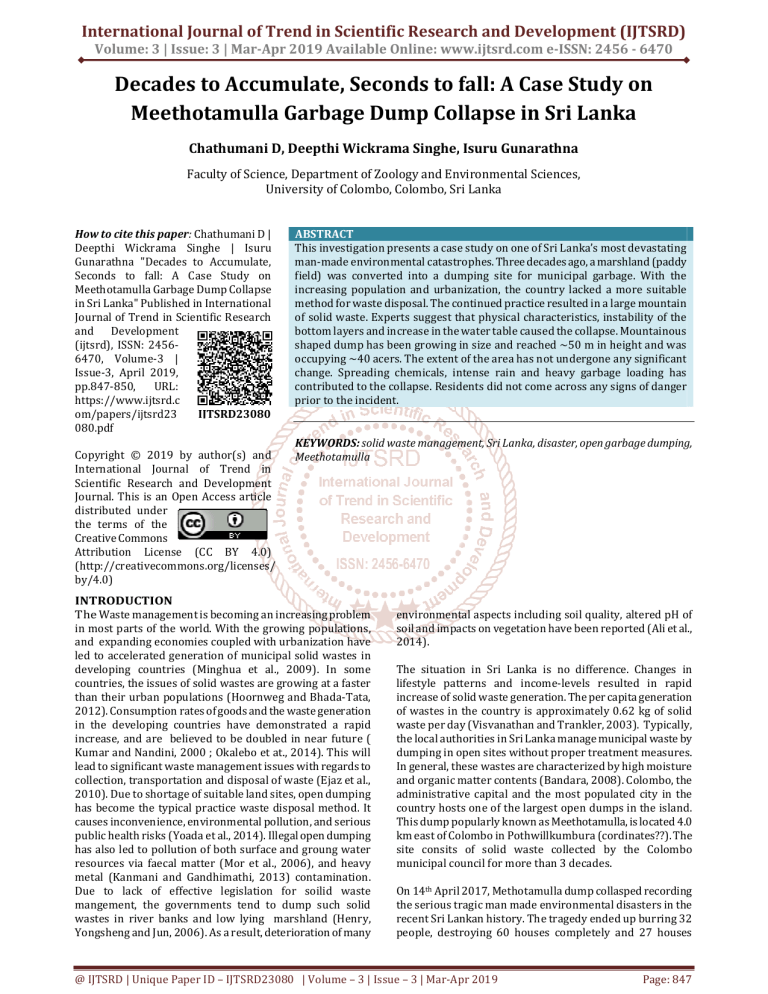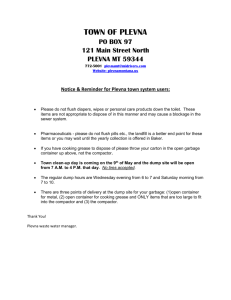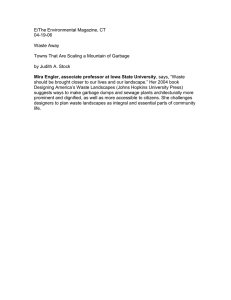
International Journal of Trend in Scientific Research and Development (IJTSRD)
Volume: 3 | Issue: 3 | Mar-Apr 2019 Available Online: www.ijtsrd.com e-ISSN: 2456 - 6470
Decades to Accumulate, Seconds to fall: A Case Study on
Meethotamulla Garbage Dump Collapse in Sri Lanka
Chathumani D, Deepthi Wickrama Singhe, Isuru Gunarathna
Faculty of Science, Department of Zoology and Environmental Sciences,
University of Colombo, Colombo, Sri Lanka
How to cite this paper: Chathumani D |
Deepthi Wickrama Singhe | Isuru
Gunarathna "Decades to Accumulate,
Seconds to fall: A Case Study on
Meethotamulla Garbage Dump Collapse
in Sri Lanka" Published in International
Journal of Trend in Scientific Research
and Development
(ijtsrd), ISSN: 24566470, Volume-3 |
Issue-3, April 2019,
pp.847-850,
URL:
https://www.ijtsrd.c
om/papers/ijtsrd23
IJTSRD23080
080.pdf
Copyright © 2019 by author(s) and
International Journal of Trend in
Scientific Research and Development
Journal. This is an Open Access article
distributed under
the terms of the
Creative Commons
Attribution License (CC BY 4.0)
(http://creativecommons.org/licenses/
by/4.0)
ABSTRACT
This investigation presents a case study on one of Sri Lanka’s most devastating
man-made environmental catastrophes. Three decades ago, a marshland (paddy
field) was converted into a dumping site for municipal garbage. With the
increasing population and urbanization, the country lacked a more suitable
method for waste disposal. The continued practice resulted in a large mountain
of solid waste. Experts suggest that physical characteristics, instability of the
bottom layers and increase in the water table caused the collapse. Mountainous
shaped dump has been growing in size and reached ~50 m in height and was
occupying ~40 acers. The extent of the area has not undergone any significant
change. Spreading chemicals, intense rain and heavy garbage loading has
contributed to the collapse. Residents did not come across any signs of danger
prior to the incident.
KEYWORDS: solid waste management, Sri Lanka, disaster, open garbage dumping,
Meethotamulla
INTRODUCTION
The Waste management is becoming an increasing problem
in most parts of the world. With the growing populations,
and expanding economies coupled with urbanization have
led to accelerated generation of municipal solid wastes in
developing countries (Minghua et al., 2009). In some
countries, the issues of solid wastes are growing at a faster
than their urban populations (Hoornweg and Bhada-Tata,
2012). Consumption rates of goods and the waste generation
in the developing countries have demonstrated a rapid
increase, and are believed to be doubled in near future (
Kumar and Nandini, 2000 ; Okalebo et at., 2014). This will
lead to significant waste management issues with regards to
collection, transportation and disposal of waste (Ejaz et al.,
2010). Due to shortage of suitable land sites, open dumping
has become the typical practice waste disposal method. It
causes inconvenience, environmental pollution, and serious
public health risks (Yoada et al., 2014). Illegal open dumping
has also led to pollution of both surface and groung water
resources via faecal matter (Mor et al., 2006), and heavy
metal (Kanmani and Gandhimathi, 2013) contamination.
Due to lack of effective legislation for soilid waste
mangement, the governments tend to dump such solid
wastes in river banks and low lying marshland (Henry,
Yongsheng and Jun, 2006). As a result, deterioration of many
environmental aspects including soil quality, altered pH of
soil and impacts on vegetation have been reported (Ali et al.,
2014).
The situation in Sri Lanka is no difference. Changes in
lifestyle patterns and income-levels resulted in rapid
increase of solid waste generation. The per capita generation
of wastes in the country is approximately 0.62 kg of solid
waste per day (Visvanathan and Trankler, 2003). Typically,
the local authorities in Sri Lanka manage municipal waste by
dumping in open sites without proper treatment measures.
In general, these wastes are characterized by high moisture
and organic matter contents (Bandara, 2008). Colombo, the
administrative capital and the most populated city in the
country hosts one of the largest open dumps in the island.
This dump popularly known as Meethotamulla, is located 4.0
km east of Colombo in Pothwillkumbura (cordinates??). The
site consits of solid waste collected by the Colombo
municipal council for more than 3 decades.
On 14th April 2017, Methotamulla dump collasped recording
the serious tragic man made environmental disasters in the
recent Sri Lankan history. The tragedy ended up burring 32
people, destroying 60 houses completely and 27 houses
@ IJTSRD | Unique Paper ID – IJTSRD23080 | Volume – 3 | Issue – 3 | Mar-Apr 2019
Page: 847
International Journal of Trend in Scientific Research and Development (IJTSRD) @ www.ijtsrd.com eISSN: 2456-6470
partially. According to an expert report, infiltration of rain
water through the garbage dump resulted in instability of
the bottom layers, increase in the water table and decrease
in the strength of the upper layers due to accumulation of
water are among contributory factors (NBRO, 2017). This
incident was an eye opener following which many steps
were taken by the government and the local authorities to
streamline the garbage disposal and management. Similar to
any other disasters, the collapse had a major impact on the
socio-economic context of the country (Shaw et al., 2003;
Shaw and Goda, 2004).
In this context, the present study was carried out with two
focuses: firstly to report and analyse the observations of the
communities living in the Meetotamulla open dump site.
Secondly, this investigation extends to present an overview
of the growth of the dumping site over 15 years using GIS
and remote sensing technologies.
Figure1. Temporal variation of Meethotamulla garbage
dump
METHODOLOGY
In a pilot survey, two administrative divisions that were
found to have been affected by the collapse of the dump,
Dhampura and Meethotamulla Grama Niladharee Divisions
(GND) located in Kolonnawa Divisional Secretariat Division
were selected as the areas of study. Residential area was
separated from the dump by a road or a strip of land. Before
the disaster happened, many families have been residing
near the outer boundaries of the dump in permanent and
temporary housing.
Data collection was carried out through a questionnaire
survey, focus group discussions and interviews with
residents of the area who have been residing near the
dumped site at the time of the collapse. One member from
each of the eight most affected families were interviewed for
thirty minutes per member by one of the two interviewees.
The information gathered focused on the history of open
dumping at Meethotamulla, environmental and sociological
problems faced by the residents, and any early signs of the
collapse. Before the focus group interviews began, all group
members were given a brief introduction about the
objectives of the study. A group of randomly selected
residents were interviewed. All responses were recorded for
further analysis. Questionnaires were distributed randomly
among the affected residents.
Subsequently satellite images extracted from google earth
were screened and digitized using Arc map 10.1. The
extracted images were depictions of the extent and the outer
appearance of the garbage dump in the years of 2004, 2009,
2012, 2014 to 2018. For each year maps were produced to
observe the variation in extent of the garbage dump and
extents were calculated.
RESULTS
Results of the questionnaire survey and discussions are
summarized below. The age of the respondents ranged from
33 to 87 years and 3 out of 16 respondents were males. All
respondents were permanent residents in the area.
Figure2. Scatter plot with regression line depicting year Vs
extent of the dump
According to the survey results, the area was a paddy field
before it was converted to a garbage dump. The
questionnaire revealed that a majority 70% of the residents
have been occupants for 20 - 24 years and therefore are well
aware about the dump and its history. Nearly 50% of the
respondents stated that garbage dumping began in 1988 and
the rest stated it was around 1987-86. During the history of
the dump of nearly three decades, there was a halt in
dumping process during 2010 and 2011. The shape of the
garbage dump was stated by the villagers as mountainous
with a height of 45 to 55 ft. while the extent was 40 to 42
acres. The majority of the witnesses of the incident stated
that the collapse was rapid and took less than a minute.
Everybody expressed that they heard a huge sound like an
explosion. However, prior to the incident, any sign of
collapse or any other alerts such as cracks were nor evident
or observed by the residents. Bursting of water pipes have
been witnessed by a few. There were different opinions
about the possible cause of the collapse. Nearly 50 % of the
respondents related to the incident to a spread of chemicals
in to the dump by the authorities. However, we did not find
any official event to prove this statement. Moreover, some
15% of the respondents believe that the incident was a
result of heavy rains as well as the spread of chemicals. The
rest was under the opinion the dump collapsed due to the
overwhelming weight of the garbage.
VARIATION IN THE EXTENT OF THE GARBAGE DUMP
The extent has been fluctuating throughout the past two
decades and the highest has been recorded in 2009.
Following figures shows the variation of extent recorded by
the satellite imagery by Google Earth®.
@ IJTSRD | Unique Paper ID - IJTSRD23080 | Volume – 3 | Issue – 3 | Mar-Apr 2019
Page: 848
International Journal of Trend in Scientific Research and Development (IJTSRD) @ www.ijtsrd.com eISSN: 2456-6470
Before the collapse in 2017, the area has been 0.06599 km2
which is not the largest recorded in the history of the
garbage dump. The following graph (figure 2) is a scatter
plot of the extent of the garbage dump against time. The
trend line for the data did not show any significant trend in
the extent of the garbage dump (R2 value is closer to 0). With
the available data, it can be suggested that variation of the
extent of the garbage dump has not played a major role in
the incident.
DISCUSSION
The collapse of Meethotamulla garbage dump was one of the
most devastating man-made environmental events in the
history of the country. The event is a significant eye opener
for environmental hazards in Sri Lanka that has brought
about changes in attitudes and practices both in the
communities as well as in the government.
One important aspect of solid waste issue in the country is
attitudes of the communities when the government took a
decision to look for alternative sites and move solid waste
dumping sites away from the cities to suburbs or remote
areas. The mind-set of the people, in general, seems not to
accept garbage from elsewhere to their residential areas.
Some unsatisfied parties went to the extent of seeking legal
remedies to stop dumping solid waste generated by the
dwellers in other parts of the country to their villages or
residential areas. After Meethotamulla incident,
communities were significantly expressing their displeasure
and fear about dumping sites. Considering numerous court
cases filed by the resident of an alternative site at
Karadiyana, the district court limited the amount and
granted permission to the municipal authorities to dump
only a maximum of 350 tons of solid wastes. Yet, a group at
the Karadiyana turned back several garbage trucks and
protested against the decision. Similarly, people of
Veyangoda and Dompe which are remote areas followed law
suit against the disposal of garbage collected from Colombo.
Protests were also staged in Uswetikeiyawa, Wattala against
the disposal of garbage in marshy lands in Muthurajawela
(Fernando, 2017).
Following the collapse, a new era of solid waste disposal
awareness, policy and regulations were initiated. Many
forums were organized by the government, community
organizations and private sector parties to discuss options
for proper solid waste management and strong media
campaigns were started to raise public awareness on
effective waste management including reducing, reusing and
recycling wastes.
After the collapse of the garbage mound, the government
took several proactive initiatives to manage solid waste
disposal in a more efficient and secure manner. One such
step to remove the garbage collected from the Colombo
Municipal Council (CMC) area to Karadiyana and Dompe
solid-waste processing centres, which were operating in a
small scale previously. Initiation of new waste management
facilities too were apparent. A new facility at the
Thambovila, Karadiyana which is capable of processing up to
500 tons solid waste per day was initiated. Another key
policy was the formulation of regulations to segregate
garbage by household or commercial level, which is now
being practiced effectively in many parts of the country.
Nevertheless, garbage dumps are creating continuous
problems due to many years of ad hoc practices, inadequate
public participation as well as institutional policy failures:
the most recent local example is fire at Mawanella garbage
dump in Kandy, which took place on 16th February 2018
destroying four acres of rubber plantation.
As sound management policies, technologies, and attitudes
could offer a wide array of environmental and social benefits
(Shang et al., 2010), including climate change mitigation
(Vergara and Tchobanoglous, 2012), both government and
communities should now work together to provide
sustainable solution for solid waste management challenges.
ACKNOWLEDGMENT
Logistical support from the University of Colombo and
contribution for improvement by Prof. D. Peiris are
gratefully acknowledged.
References
[1] Ali, S. M., Pervaiz, A., Afzal, B., Hamid, N. and Yasmin, A.
(2014) ‘Open dumping of municipal solid waste and its
hazardous impacts on soil and vegetation diversity at
waste dumping sites of Islamabad city’, Journal of King
Saud University - Science. King Saud University, 26(1),
pp. 59–65. doi: 10.1016/j.jksus.2013.08.003.
[2] Bandara, N. J. G. J. (2008) ‘Municipal Solid Waste
Management – The Sri Lankan Case Nilanthi’,
Conference on Developments in Forestry and
Environment Management in Sri Lanka, 0(0). doi:
10.31357/fesympo.v0i0.21.
[3] Ejaz, N., Akhtar, N., Nisar, H. and Ali Naeem, U. (2010)
‘Environmental impacts of improper solid waste
management in developing countries: A case study of
Rawalpindi City’, WIT Transactions on Ecology and the
Environment,
142,
pp.
379–387.
doi:
10.2495/SW100351.
[4] Fernando, L. (2017) Meethotamulla tragedy: Alternate
dumping sites spark protests from locals - Sri Lanka
Latest
News.
Available
at:
https://www.newsfirst.lk/2017/04/20/meethotamull
a-tragedy-alternate-dumping-sites-spark-protestslocals/ (Accessed: 22 January 2019).
[5] Henry, R. K., Yongsheng, Z. and Jun, D. (2006)
‘Municipal solid waste management challenges in
developing countries - Kenyan case study’, Waste
Management,
26(1),
pp.
92–100.
doi:
10.1016/j.wasman.2005.03.007.
[6] Hoornweg, D. and Bhada-Tata, P. (2012) ‘What a
Waste : A Global Review of Solid Waste Management’.
World Bank, Washington, DC. Available at:
https://openknowledge.worldbank.org/handle/10986
/17388 (Accessed: 15 November 2018).
[7] Kanmani, S. and Gandhimathi, R. (2013) ‘Assessment of
heavy metal contamination in soil due to leachate
migration from an open dumping site’, Applied Water
Science, 3(1), pp. 193–205. doi: 10.1007/s13201-0120072-z.
[8] Minghua, Z., Xiumin, F., Rovetta, A., Qichang, H.,
Vicentini, F., Bingkai, L., Giusti, A. and Yi, L. (2009)
‘Municipal solid waste management in Pudong New
@ IJTSRD | Unique Paper ID - IJTSRD23080 | Volume – 3 | Issue – 3 | Mar-Apr 2019
Page: 849
International Journal of Trend in Scientific Research and Development (IJTSRD) @ www.ijtsrd.com eISSN: 2456-6470
Area, China’, Waste Management. Elsevier Ltd, 29(3),
pp. 1227–1233. doi: 10.1016/j.wasman.2008.07.016.
[9] Mor, S., Ravindra, K., Dahiya, R. P. and Chandra, A.
(2006) ‘Leachate characterization and assessment of
groundwater pollution near municipal solid waste
landfill site’, Environmental Monitoring and
Assessment,
118(1–3),
pp.
435–456.
doi:
10.1007/s10661-006-1505-7.
[10] Okalebo, S. E., Opata, G. P. and and Mwasi, B. N. (2014)
‘An analysis of the household solid waste generation
patterns and prevailing management practices in
Eldoret’, International Journal of Agricultural Policy
and Research, 2(February), pp. 76–89.
[11] RFE/RL’s Russian Service (2018) New Protest Held
Against Volokolamsk Landfill Near Moscow. Available
at:
https://www.rferl.org/a/russia-volokolamskanother-protest-toxic-garbage-dump-leakchildren/29121270.html (Accessed: 22 January 2019).
[12] Social Movement responding to the Lebanese Garbage
Crisis | Civil Society Knowledge Centre (no date).
Available
at:
https://civilsocietycentre.org/party/social-movement-respondinglebanese-garbage-crisis (Accessed: 22 January 2019).
[13] Visvanathan, C. and Trankler, J. (2003) ‘Municipal Solid
Waste Management in Asia: A Comparative Analysis C.
Visvanathan and J. Trankler’, Journal, (November), pp.
1–14. doi: 10.18517/ijaseit.2.2.169.
[14] Yoada, R. M., Chirawurah, D. and Adongo, P. B. (2014)
‘Domestic waste disposal practice and perceptions of
private sector waste management in urban Accra’, BMC
Public Health, 14(1), pp. 1–10. doi: 10.1186/14712458-14-697.
[15] Kumar. M and Nandini. N (2000) Community attitude,
perception and willingness towards solid waste
management in Bangalore city, Karnataka, India
International Journal of Environmental Sciences
Volume 4 No.1 2013 95
[16] Vergara, S. E. and Tchobanoglous, G. (2012) . Municipal
Solid Waste and the Environment: A Global
Perspective. Annual Review of Environment and
Resources. Vol. 37:277-309
[17] Zhang, Dong Qing, Soon Keat Tan, and Richard M.
Gersberg. 2010. "Municipal solid waste
[18] Management in China: status, problems
challenges." Journal of Environmental
and
[19] Management 91.8 (2010): 1623-1633.
[20] Shaw R and Goda K (2004) “From disaster to
sustainable civil society: the Kobe experience” Disaster
28(1):16–40
[21] Shaw R, Gupta M and Sharma A (2003) “Community
recovery and its sustainability: lessons from Gujarat
earthquake in India” The Australian Journal of
Emergency Management 18(2):28–34.
@ IJTSRD | Unique Paper ID - IJTSRD23080 | Volume – 3 | Issue – 3 | Mar-Apr 2019
Page: 850








